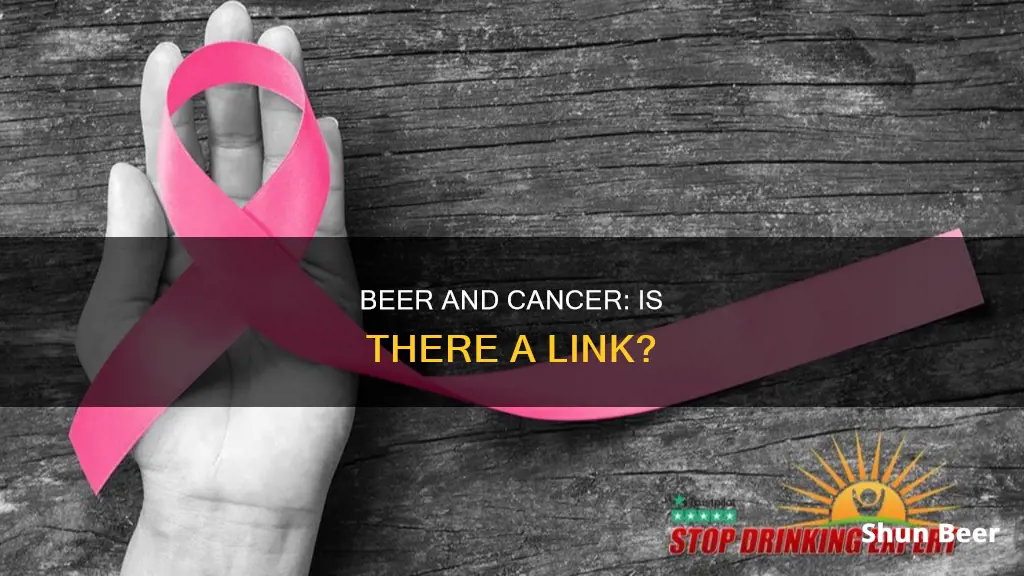
Drinking multiple beers a day can increase your risk of developing cancer. Alcohol is a Group 1 carcinogen, which is the same ranking given to tobacco and solar radiation. According to the National Institute on Alcohol Abuse and Alcoholism, a standard alcoholic drink in the United States contains 14 grams of pure alcohol, which is typically found in 12 ounces of beer. The more alcohol a person drinks, the higher their risk of developing an alcohol-associated cancer. Moderate drinkers have a 10% increased risk of getting cancer, while heavy drinkers are most at risk. Alcohol is estimated to be the third-largest contributor to overall cancer deaths. It increases the risk of developing head and neck, breast, colorectal, esophageal, liver, stomach, and pancreatic cancers.
What You'll Learn

Alcohol is a Group 1 carcinogen
The link between alcohol and cancer has been well-established through numerous studies. According to the National Cancer Institute, there is a strong scientific consensus that alcohol consumption can lead to various types of cancer. This consensus is supported by the National Toxicology Program of the US Department of Health and Human Services, which lists alcoholic beverages as a known human carcinogen in its Report on Carcinogens.
The risk of developing alcohol-associated cancer increases with the amount of alcohol consumed. Even moderate drinking, defined as one to five drinks per week, has been associated with a slightly elevated risk of cancer. However, the risk becomes more significant with heavier drinking. For example, men who drank three or more drinks per day had three to four times the risk of developing esophageal or liver cancer compared to non-drinkers.
Alcohol is estimated to be the third-largest contributor to overall cancer deaths, with approximately 3.5% of cancer deaths in a given year being alcohol-related. This equates to about 19,500 deaths per year in the United States alone. In the WHO European Region, alcohol consumption is responsible for an even higher proportion of cancer deaths, with alcohol-attributable cancers being the leading cause of death.
The mechanisms by which alcohol contributes to cancer development are multifaceted. One key factor is the conversion of alcohol into acetaldehyde, a highly toxic substance and known carcinogen. Acetaldehyde can damage DNA and proteins, leading to cellular mutations and uncontrolled cell growth that can result in tumors. Alcohol can also cause oxidative stress, impair nutrient absorption, and increase estrogen levels, all of which can contribute to cancer development.
In summary, alcohol is a Group 1 carcinogen, posing a significant risk factor for several types of cancer. The link between alcohol consumption and cancer is well-established, and the risk increases with the amount of alcohol consumed. While moderate drinking may be associated with a slightly lower risk of cancer compared to abstinence, the optimal number of drinks to minimize overall health risk is zero.
Alcohol-Free Beer: A Safe Choice for Alcoholics?
You may want to see also

Alcohol increases the risk of breast cancer
Alcohol is a known carcinogen, and excessive drinking is linked to a heightened risk of developing several types of cancer. While previous studies have associated moderate alcohol consumption with improved heart health and longevity, emerging research highlights a clear link between alcohol and cancer.
Alcohol and Breast Cancer
Alcoholic drinks contain ethanol or ethyl alcohol, a chemical substance that is broken down by the body into acetaldehyde, a highly toxic substance and known carcinogen. Acetaldehyde can cause permanent DNA damage, triggering a response in the body that leads to cancerous cells developing.
Alcohol consumption is associated with an increased risk of developing breast cancer. This risk starts to increase even at low levels of drinking. Epidemiologic studies have consistently found a link between increasing alcohol intake and a heightened risk of breast cancer. Pooled data from 118 individual studies indicates that light drinkers have a slightly increased (1.04-fold higher) risk of breast cancer compared to non-drinkers. The risk increases further for moderate drinkers (1.23-fold higher) and heavy drinkers (1.6-fold higher).
Alcohol consumption can increase levels of the female hormone oestrogen. High levels of oestrogen can cause vulnerable cells to multiply excessively and become cancerous. Alcohol is also associated with unwanted weight gain, and excess fat can lead to an increased risk of cancer.
Reducing the Risk
The risk of developing breast cancer is influenced by factors such as age, family history, and lifestyle choices. While some of these factors are beyond individual control, others, such as alcohol consumption, can be managed. To reduce the risk of alcohol-related cancers, it is advisable to limit alcohol intake to no more than one drink per day for women and two drinks per day for men. It is also recommended to incorporate several alcohol-free days into your weekly routine.
Beer and Swollen Ankles: Is There a Connection?
You may want to see also

Alcohol increases the risk of head and neck cancers
Alcohol is indeed linked to an increased risk of developing several types of cancer, including head and neck cancers. Moderate to heavy alcohol consumption is associated with higher risks of certain head and neck cancers. This includes oral cavity, pharynx (throat), and larynx (voice box) cancers.
Here's a more detailed breakdown of the risks:
- Moderate drinkers have 1.8 times higher risk of oral cavity (excluding lips) and pharynx cancers and 1.4 times higher risk of larynx cancers compared to non-drinkers.
- Heavy drinkers have up to 5 times higher risk of oral cavity and pharynx cancers and 2.6 times higher risk of larynx cancers.
- The risks are substantially higher for those who consume alcohol and also use tobacco.
The link between alcohol and head and neck cancers is particularly strong for cancers of the upper digestive tract, such as the oral cavity and esophagus. This is because alcohol comes into direct contact with the tissue in these areas.
The evidence suggests that the more alcohol a person consumes, the higher their risk of developing these cancers. Even light drinking can increase the risk to some extent. Light drinking is typically defined as up to one drink per day for women and up to two drinks per day for men, or less than or equal to 12.5 grams of alcohol per day. Moderate drinking is defined as less than or equal to 50 grams of alcohol per day, and heavy drinking is defined as greater than 50 grams of alcohol per day.
The mechanism by which alcohol increases the risk of head and neck cancers is thought to be related to the production of acetaldehyde, a toxic byproduct of alcohol metabolism. Acetaldehyde is a known carcinogen that can damage DNA and trigger cancer-causing mutations. Additionally, alcohol can cause oxidative stress, impair nutrient absorption, and increase estrogen levels, all of which can contribute to cancer development.
It's important to note that the link between alcohol consumption and cancer risk is not just limited to head and neck cancers. Alcohol is also associated with increased risks of breast, colorectal, esophageal, liver, stomach, and pancreatic cancers.
Is Non-Alcoholic Beer Safe for Children to Drink?
You may want to see also

Alcohol increases the risk of liver cancer
Alcohol is a Group 1 carcinogen, which is the same ranking given to tobacco and solar radiation. While this does not mean that drinking is as bad for you as smoking, it does indicate that there is a strong body of evidence showing that exposure to alcohol can cause cancer.
According to the National Institute on Alcohol Abuse and Alcoholism, a standard alcoholic drink in the United States contains 14 grams of pure alcohol. This amount of alcohol is typically found in 12 ounces of beer, 5 ounces of wine, or 1.5 ounces of 80-proof liquor.
Heavy alcohol consumption is associated with a significantly increased risk of developing liver cancer. Regular, heavy alcohol use can lead to inflammation and scarring of the liver, which may explain the heightened risk of liver cancer among heavy drinkers. Specifically, heavy drinking is linked to approximately a two-fold increase in the risk of two types of liver cancer: hepatocellular carcinoma, the most common form, and intrahepatic cholangiocarcinoma.
The link between alcohol consumption and liver cancer is supported by a meta-analysis of 112 publications, which found that compared to non-drinkers or very light drinkers, ever-drinkers had a 1.29 to 1.46 times higher risk of liver cancer. Further, the analysis revealed a clear dose-response relationship between alcohol and liver cancer. Consuming 12 grams of alcohol per day (approximately one drink) was associated with a 1.08-fold increase in liver cancer risk, while consuming 125 grams of alcohol per day (approximately ten drinks) was associated with a 5.20-fold increase in risk.
In addition to increasing the risk of liver cancer, heavy drinking can also cause irreversible damage to the liver, known as cirrhosis. Cirrhosis is a significant risk factor for hepatocellular carcinoma and can be life-threatening. Thus, it is essential for individuals who engage in heavy drinking to seek medical advice and reduce their alcohol intake to mitigate these risks.
Brewery Beer: Can I Drink It Elsewhere?
You may want to see also

Alcohol increases the risk of esophageal cancer
Alcohol consumption is linked to an increased risk of developing esophageal cancer. This risk is heightened when alcohol is consumed alongside tobacco. According to the National Cancer Institute, alcohol consumption at any level is associated with a heightened risk of a type of esophageal cancer called esophageal squamous cell carcinoma. Compared to no alcohol consumption, the risk ranges from 1.3 times higher for light drinking to nearly 5 times higher for heavy drinking.
The link between alcohol and esophageal cancer is well-established. A 2023 analysis by the International Agency for Research on Cancer found that reducing or eliminating alcohol consumption lowered the risk of developing esophageal cancer. This finding was supported by a 2018 study, which concluded that alcohol is the third-leading cause of cancer deaths in the United States, with around 3.5% of all cancer deaths (approximately 19,500 deaths) in a given year attributed to alcohol.
The mechanism by which alcohol increases the risk of esophageal cancer is through its metabolization to a compound called acetaldehyde. This conversion occurs due to the microbes in the gastrointestinal tract and starts in the mouth. Acetaldehyde is a potent genotoxic compound that can damage DNA and cause cancer. Additionally, alcohol can increase inflammation, cause oxidative stress, and affect sex hormone levels, further influencing cancer risk.
The risk of developing esophageal cancer is also influenced by genetic factors. For example, individuals of East Asian descent may carry a defective variant of the aldehyde dehydrogenase 2 (ALDH2) enzyme, which is responsible for converting toxic acetaldehyde into nontoxic substances. As a result, acetaldehyde tends to build up in their bodies when they consume alcohol, increasing their risk of esophageal cancer.
It is important to note that the risk of esophageal cancer associated with alcohol consumption can be mitigated by reducing or ceasing alcohol intake. According to the International Agency for Research on Cancer's analysis, quitting alcohol for 15 years or more was linked to a 65% relative risk reduction for esophageal cancer. Therefore, individuals concerned about their risk should consider reducing their alcohol consumption or abstaining from alcohol altogether.
Understanding Beer Distribution: From Brewery to Glass
You may want to see also
Frequently asked questions
Yes, drinking multiple beers a day can increase your risk of developing several types of cancer. According to the American Society of Clinical Oncology, drinking alcohol is linked to a higher chance of developing cancers of the oral cavity, pharynx, esophagus, larynx, liver, and colorectum, as well as breast cancer in women.
The recommended daily limit for alcohol consumption is no more than one drink per day for women and no more than two drinks per day for men. One drink is typically defined as 12 fluid ounces of beer, 5 fluid ounces of wine, or 1.5 fluid ounces of 80-proof liquor.
Alcohol consumption is associated with an increased risk of head and neck cancers, breast cancer, colorectal cancer, esophageal cancer, liver cancer, stomach cancer, and pancreatic cancer.
Alcohol contains ethanol, which is broken down by the body into acetaldehyde, a known carcinogen that damages DNA and impairs the body's ability to repair the damage, leading to cancerous cell growth. Alcohol can also affect hormone levels, reduce nutrient absorption, contribute to weight gain, and increase the sensitivity to other carcinogens.
Yes, reducing alcohol intake can lower your cancer risk. The less you drink, the better. However, the greatest risk reduction comes from abstaining from alcohol completely.







